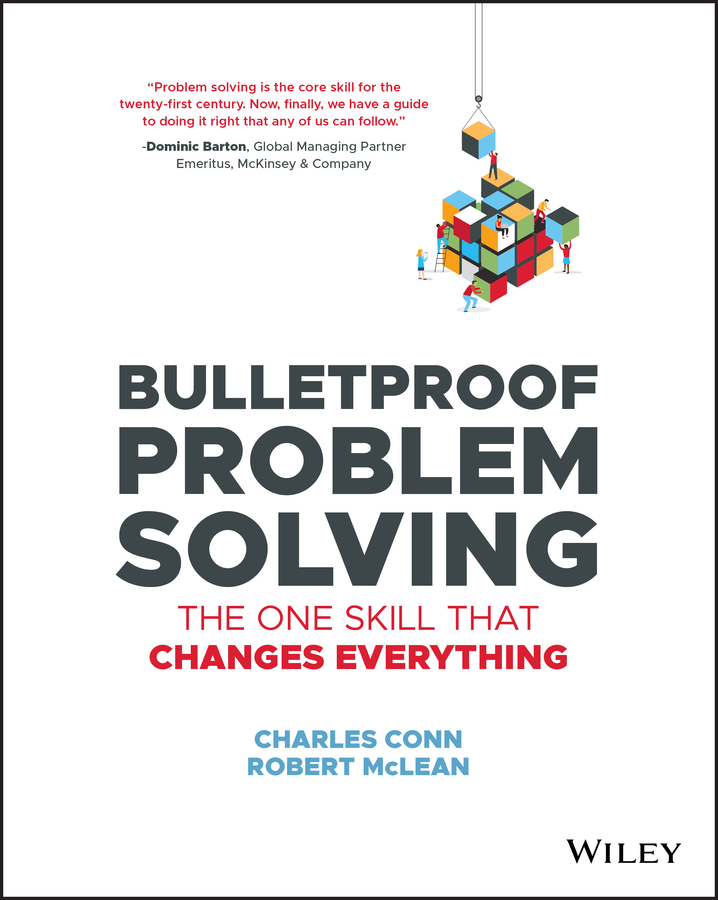


“The Bulletproof Problem Solving approach acknowledges the reality many environmentalists face today: this is hard work. Conn and McLean's guide makes it a little bit easier.”
‐Mark R. Tercek, CEO of The Nature Conservancy and author of Nature's Fortune
“Conn and McLean have distilled their matchless experience in attacking challenges of every scale and level of complexity into this virtual war‐room of a book, creating an indispensable resource for the 21st century problem‐solvers upon whom our future depends. A must‐read for all aspiring change agents!”
‐Sally Osberg, retired CEO of the Skoll Foundation, co‐author of Getting Beyond Better: How Social Entrepreneurship Works
“Navigating ambiguity and solving complex problems creatively is the truth test for humans to complement rather than substitute the artificial intelligence of computers. Without much better approaches to teach those skills, our schools risk preparing second class robots rather than first class humans. Rob McLean and Charles Conn show that this can be done and provide an intuitive roadmap for how to do this, with lots of real‐world examples that make it fun.”
‐Andreas Schleicher, Director for the Directorate of Education and Skills, OECD
“Great strategic problem solving is an essential tool, one whose value is only going up. Bulletproof provides the secret sauce behind the McKinsey framework to help structure and guide the problem‐solving process. I want to hire people who understand this approach.”
‐Barry Nalebuff, Milton Steinbach Professor, Yale School of Management and cofounder, Honest Tea
“The old paradigm of strategy departments and planning cycles has been overthrown by agile and rapid team‐based problem solving, providing better solutions and better organization alignment to implement. This book, written by two of the smartest people I know, provides the needed blueprint for how build these world‐beating problem solving teams.”
‐Mehrdad Baghai, Chair of Alchemy Growth and author of As One
“The world has never been in more need of extraordinary problem solvers‐in business and every other walk of life. Rob McLean and Charles Conn powerfully demonstrate that problem solving is a structured process that can be learned and applied to the benefit of everybody. Their book is such an important contribution to the resolution of our biggest problem solving challenges.”
‐Nick Lovegrove, Professor of the Practice, Georgetown University and author of The Mosaic Principle
Copyright © 2018 by Charles Conn and Robert McLean. All rights reserved.
Published by John Wiley & Sons, Inc., Hoboken, New Jersey.
Published simultaneously in Canada.
No part of this publication may be reproduced, stored in a retrieval system, or transmitted in any form or by any means, electronic, mechanical, photocopying, recording, scanning, or otherwise, except as permitted under Section 107 or 108 of the 1976 United States Copyright Act, without either the prior written permission of the Publisher, or authorization through payment of the appropriate per‐copy fee to the Copyright Clearance Center, Inc., 222 Rosewood Drive, Danvers, MA 01923, (978) 750‐8400, fax (978) 646–8600, or on the Web at www.copyright.com. Requests to the Publisher for permission should be addressed to the Permissions Department, John Wiley & Sons, Inc., 111 River Street, Hoboken, NJ 07030, (201) 748–6011, fax (201) 748–6008, or online at www.wiley.com/go/permissions.
Limit of Liability/Disclaimer of Warranty: While the publisher and author have used their best efforts in preparing this book, they make no representations or warranties with respect to the accuracy or completeness of the contents of this book and specifically disclaim any implied warranties of merchantability or fitness for a particular purpose. No warranty may be created or extended by sales representatives or written sales materials. The advice and strategies contained herein may not be suitable for your situation. You should consult with a professional where appropriate. Neither the publisher nor author shall be liable for any loss of profit or any other commercial damages, including but not limited to special, incidental, consequential, or other damages.
For general information on our other products and services or for technical support, please contact our Customer Care Department within the United States at (800) 762‐2974, outside the United States at (317) 572–3993, or fax (317) 572–4002.
Wiley publishes in a variety of print and electronic formats and by print‐on‐demand. Some material included with standard print versions of this book may not be included in e‐books or in print‐on‐demand. If this book refers to media such as a CD or DVD that is not included in the version you purchased, you may download this material at http://booksupport.wiley.com. For more information about Wiley products, visit www.wiley.com.
Library of Congress Cataloging‐in‐Publication Data is Available:
ISBN 9781119553021 (Paperback)
ISBN 9781119553045 (ePDF)
ISBN 9781119553038 (ePub)
Cover Design: Wiley
Cover Image: © Marish/Shutterstock
Bulletproof. At McKinsey there is no greater compliment than to have your reputation as a problem solver described as “bulletproof.” While it takes many skills and types of intelligence to make a modern consulting firm work, the cornerstone capability is always creative problem solving.
The importance of great problem solving has only grown as the pace of economic and technological change has accelerated in recent years—and the scope and complexity of the problems we need to address increases alongside it. Today we are just as likely to be hired to help a country public health system prepare for the next Ebola outbreak as to develop a digital marketing strategy for a new consumer product. As ever more data becomes available, the bar on the quality of thinking rises. We need bulletproof problem solvers.
Whether you work in industry, the nonprofit sector, or government, there is no way to anticipate and plan for the new structures and operating rules that are unfolding. Nor is simply accelerating and adapting traditional, domain‐oriented, training approaches sufficient. The only way to successfully navigate this level of change is to be a fluid and creative problem solver. That's why the World Economic Forum labeled complex problem solving its number one skill for the twenty‐first century. Organizations everywhere are looking for this capability in their talent recruiting above all else.
What is perhaps surprising is that a disciplined, comprehensive approach to problem solving isn't taught in schools or universities. It is absent from most curricula even in many business schools. You can see elements in things like root‐cause analysis or the current vogue for agile teams and design thinking, but they don't go far enough. This book introduces the systematic process for problem solving that has been missing, a version of the time‐tested methodology we have used for many years in McKinsey.
The seven‐step method Charles and Rob demonstrate here is transparent and straightforward. It doesn't require specialist skills or fancy mathematical talent—though the authors do show when more sophisticated analytic techniques can be valuable, and why they are often more accessible than you think. It is iterative and flexible; it can be applied quickly to get rough‐cut answers, and more slowly to fine‐tune nuanced answers. It shows how to fight the human biases in decision making that we have learned so much about in recent years. And it works on nearly any kind of problem, from personal life decisions, to business and nonprofit questions, to the biggest policy challenges facing society.
As a longtime runner, I was especially drawn to Rob's analysis of whether or not to have knee surgery. I was also impressed by the straightforward analysis that can help voters consider their response to complicated policy decisions in areas like fisheries and educational funding. I naturally enjoyed reading the cases covering business strategy or enhancing profitability. And while there are some genuinely intractable social and environmental problems, this methodology can still shine light on solution paths to even the trickiest challenges, including fighting climate change and obesity.
You couldn't ask for more qualified authors to write a book of this kind. Charles drafted the original internal McKinsey presentation on problem solving, 7 Easy Steps to Bulletproof Problem Solving, one of our most requested professional development documents ever, when we were young consultants in Toronto. I have known Rob for more than 35 years, starting with a project we did together on how to leverage the time of the CEO of Australia's largest company. During their time at McKinsey, Rob and Charles collaborated with other colleagues to develop the horizons approach to growth strategy that we still use today. After they left the firm, I enjoyed watching them both continue to apply their problem solving method as entrepreneurs and as change makers in the nonprofit sector. In recent years I have had a front‐row seat as Charles brought this distinctive mindset to strategy development and transformation at the Rhodes Trust.
Problem solving is the core skill for the twenty‐first century. Now, finally, we have a guide to doing it right that any of us can follow.
Dominic Barton
Managing Director (Retired), McKinsey & Company
Great problem solving has never been more important for business and society. The problems facing humankind are larger, more complex, and moving faster than ever before. Previous approaches to training for careers are now outmoded as change in technologies and business models accelerates. Learning how to define a problem, creatively break it into manageable parts, and systematically work toward a solution has become the core skill for the twenty‐first century workforce, the only way to keep up. But how problem solving is taught in our schools, universities, businesses, and organizations is coming up short. We need a new approach.
Let's start with a definition:

We all know the consequences of poor problem solving can be costly to business and communities, human health, and the environment. This book introduces a long‐tested and systematic approach that can be taught to anyone who wants to become a better problem solver, from corporate strategists to nonprofit workers. This powerful framework, Bulletproof Problem Solving, is an approach we learned and helped develop at McKinsey & Company, the global consulting firm. This seven‐step process hasn't been shared widely outside McKinsey until now. It can be used by individuals, teams, executives, government policy makers, and social entrepreneurs—anyone with a complex and uncertain problem of consequence. This systematic approach to problem solving could help you get a great job, make you more effective in your work, make your role as a citizen more fulfilling, and even make your personal life work better. These are big claims, but we know it works.
This new era of focus on creative problem solving has been ushered in by massive disruption of the old order in business and society. New business models are rapidly emerging from revolutionary Internet, machine learning, and bioscience technologies that threaten the status quo in every field. New rules are being written for conducting business and dealing with social and environmental challenges. Succeeding requires complex problem solving skills as never before. If you're a product manager who faces disruptive competition, you need to have a game plan and command of resources to overcome competition. You will only get resources if you make a persuasive case based on hypotheses about a winning plan, accompanied by analysis to support the key propositions. If you're a nonprofit leader of a team dealing with communities facing generational disadvantage who has seen new initiatives come and go, you have to be able to articulate a theory of change that links issues with interventions and outcomes if you want support from the board of your organization.
As organizations seek to become clever and agile to address this new world, they take on the persona of problem solving organizations—a drive to be working on the right problems, addressing root causes, engaging teams around short duration work plans, and allocating responsibilities and timelines with accountability. Over the course of our careers, we have seen the focus of organizational capability aspirations shift through distinct eras: from strategy to execution to complex problem solving.
The 70s and 80s were characterized by intense interest in strategy development. That was displaced by an era from the 90s onward that focused on execution, including deep attention to getting things done, as exemplified by the book Execution by Ram Charan and Larry Bossidy, and a number of books on business process redesign.1 However, a ruthless focus on execution assumes you have strategic direction right and can adapt to new competition, frequently from outside your industry. This can no longer be assumed.
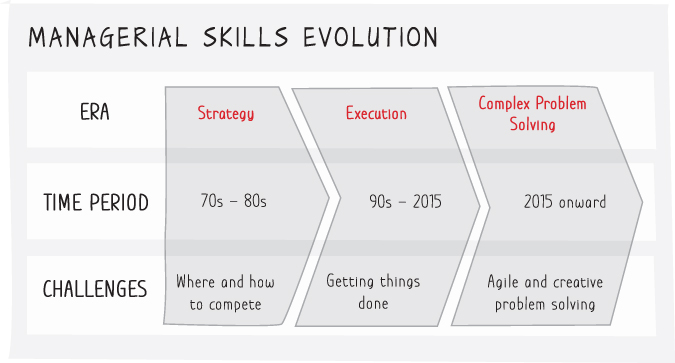
As this new era of the problem solving organization takes hold, we expect it will trigger even more interest in how teams go about sharpening complex problem solving and critical thinking skills—what is called mental muscle by the authors of The Mathematical Corporation.2 The other side of the equation is the increasing importance of machine learning and artificial intelligence in addressing fast‐changing systems. Problem solving will increasingly utilize advances in machine learning to predict patterns in consumer behavior, disease, credit risk, and other complex phenomena, termed machine muscle.
To meet the challenges of the twenty‐first century, mental muscle and machine muscle have to work together. Machine learning frees human problem solvers from computational drudgery and amplifies the pattern recognition required for faster organizational response to external challenges. For this partnership to work, twenty‐first century organizations need staff who are quick on their feet, who learn new skills quickly, and who attack emerging problems with confidence. The World Economic Forum in its Future of Jobs Report3 placed complex problem solving at #1 in its top 10 skills for jobs in 2020. Here is their list of important skills that employers are seeking:
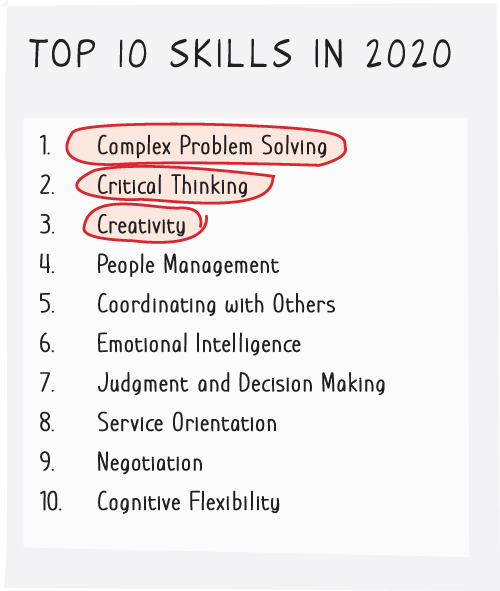
It is becoming very clear that job growth is focused in areas where tasks are nonroutine and cognitive, versus routine and manual. The intersection of nonroutine tasks and cognitive ability is the heartland of complex problem solving. The authors of a recent McKinsey Quarterly article made the point that “more and more positions require employees with deeper expertise, more independent judgment, and better problem solving skills.”4 We are already seeing that many organizations place a premium on analytic skills and problem solving and make it the essential criterion to be hired. Commentator David Brooks of the New York Times takes this conclusion even further when he says, “It doesn't matter if you are working in the cafeteria or the inspection line of a plant, companies will only hire people who can see problems and organize responses.”5
If creative problem solving is the critical twenty‐first century skill, what are schools and universities doing to develop these skills in students? Not enough. It remains early days in codifying and disseminating problem solving best practices in educational institutions. Andreas Schleicher, Director of Education and Skills and Special Advisor to the Secretary General of the OECD, explains the need for developing problem solving skills in students this way: “Put simply, the world no longer rewards people just for what they know—Google knows everything—but for what they can do with what they know. Problem solving is at the heart of this, the capacity of an individual to engage in cognitive processing to understand and resolve problem situations where a method of solution is not immediately obvious.”6
The OECD Program for International Student Assessment (PISA) started testing individual problem solving skills in 2012 and added collaborative problem solving skills in the 2015 assessments. One of the interesting early findings is that to teach students to become better problem solvers involves other capabilities than simply teaching reading, mathematics, and science literacy well. Capabilities such as creativity, logic, and reasoning are essential contributors to students becoming better problem solvers. That is what this book is about.
Universities and colleges are being challenged to demonstrate that their graduates have developed problem solving skills to prepare them for the demands of the workplace. One method of evaluating whether over a college degree there is improvement in critical thinking is the CLA+ test (Collegiate Learning Assessment plus) developed by the nonprofit Council for Aid to Education (CAE). The Wall Street Journal reported in 2017 that of the 200 colleges that apply the test “a majority of colleges that took the CLA+ made measurable progress in critical thinking”—although some well‐respected colleges didn't show much difference between incoming freshmen scores and those of seniors.7 Effective university approaches to develop critical thinking and problem solving range from analyzing classic poems like Beowulf, to teaching logic structures, and setting practical group projects that require demonstration of problem solving abilities. What we glean from the article and college practices generally is an awakening of interest in student problem solving, and expectations that problem solving will be enhanced over the course of a degree program. But we have not seen a common framework or process emerge yet.
The heart of the book is a seven‐step framework for creative problem solving, Bulletproof Problem Solving, starting with these critical questions:
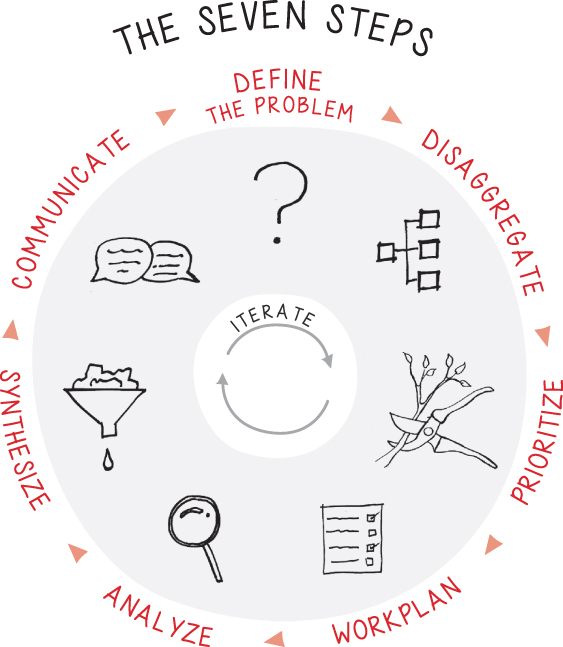
In the book we take you through the seven steps in a way that builds understanding and mastery through examples. We highlight a variety of analytic tools available to aid this process, from clever heuristics, analytic short cuts, and back‐of‐the‐envelope calculations, to sophisticated tools such as game theory, regression analysis, and machine learning. We also show how common cognitive biases can be addressed as part of the problem solving process.
The final two chapters explicitly deal with how you solve problems when uncertainty is high and interdependencies or systems effects are significant. We believe that even the so‐called “wicked problems” of society can be tackled, such as obesity and environmental degradation. These are tough problems that have multiple causes, are affected by externalities, require human behavioral change, and have some solutions that may bring unintended consequences. These chapters are for people dealing with advanced problem solving situations, but the cases are fascinating reading for anyone interested in the major issues business and society needs to address.
Good problem solving has the potential to save lives and change the fortunes of companies, nonprofits, and governments. On the other hand, mistakes in problem solving are often very costly and sometimes can cause great harm, as we saw in the Space Shuttle Challenger disaster.
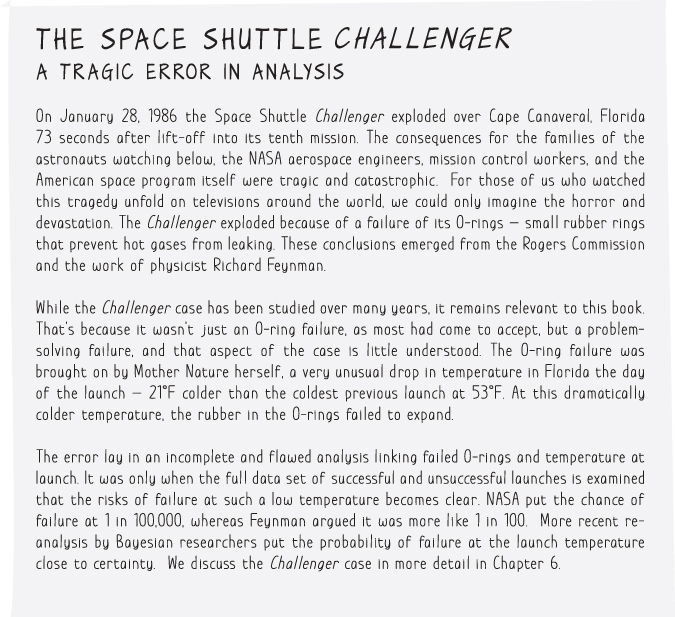
When we listen to people describe their approach to problem solving, they invariably identify one step they feel they do well. Some will confidently describe their approach to problem definition as SMART (specific, measurable, actionable, relevant, and time frame); others will cite their knowledge of inductive and deductive logic; some will point to their workplans bringing accountability to team processes; many will point to their ability to do fact gathering and analysis; and a few will mention the way they use the pyramid principle to write a persuasive document with a governing thought. But we see very few who say they do all the above, coupled with a way to cleave problems and address bias. To do good problem solving, you have to do all the steps in concert. This is what is so powerful and distinctive about the seven‐steps process.
Despite increasing focus on problem solving in schools and universities, businesses, and nonprofits, we find that there is confusion about what good problem solving entails, There are a number of pitfalls and common mistakes that many make. These include:
This is a how‐to book. We work through 30 real‐world examples, employing a highly visual logic‐tree approach, with more than 90 graphics. These are drawn from our experience and honed over an intensive summer of research with a team of Rhodes Scholars in Oxford. They include problems as diverse as the supply of nurses in the San Francisco Bay Area, to capital investment decisions in an Australian mining company, to reduction of the spread of HIV in India, to air pollution and public health in London, to competitive dynamics in the hardware home‐center industry, and even to approaches to address climate change. The insights in some cases are novel, in other cases counterintuitive. The real‐world examples behind the cases have created value amounting to billions of dollars, saved hundreds of thousands of lives, and improved the future for endangered species like salmon.
If you want to become a better problem solver, we show how you can do so with only a modest amount of structure and numeric ability. Individuals make decisions that have lifetime consequences—such as career choice, where to live, their savings plan, or elective surgery—often without due consideration. These are among the examples we walk you through in the book to illustrate the value of a structured process to improve your prospects of better outcomes in your own life.
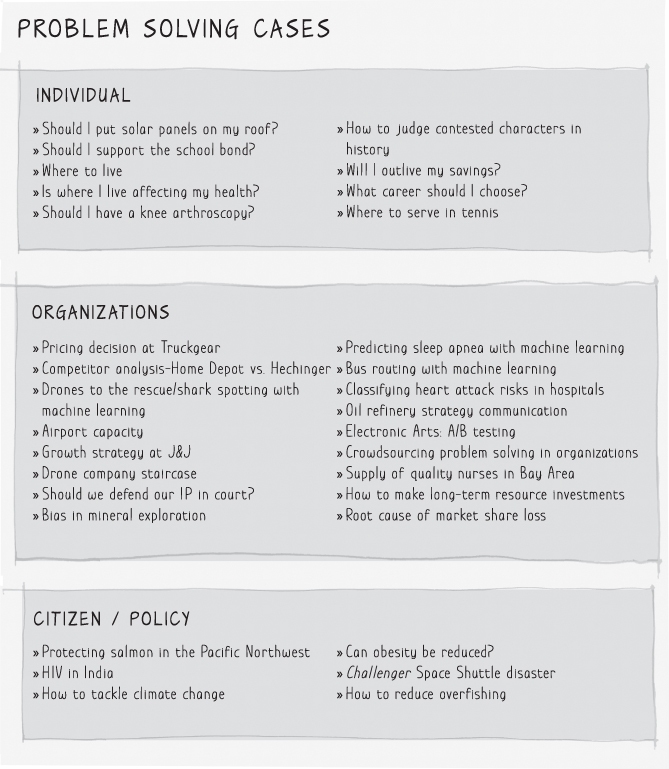
As citizens we have a desire to understand issues of the day more clearly and to be able to make a contribution to resolving them. There is a temptation to say, “That issue is way too complex or political for me to add a perspective.” We hope to change your mind about that. There are few bigger problems on the planet than climate change, obesity, reducing the spread of infectious disease, and the protection of species, and we demonstrate how to tackle problems also at this societal scale.
For college students and graduates in analytical roles we hope this book will become an important resource for you—a comprehensive suite of tools and approaches that can make you a better problem solver, one you will return to again and again. For managers we set out how to evaluate your competitor's performance, decide where and how to compete, and develop a strategy in uncertain and complex settings.
Our aim is simple: to enable readers to become better problem solvers in all aspects of their lives. You don't need post‐graduate training to be an effective problem solver. You do need to be prepared to work through a process and develop cases of your own where you can try‐test‐learn the framework. This quote from Nobel Laureate Herb Simon captures much of what we set out to do in the book: “Solving a problem simply means representing it so as to make the solution transparent.”11